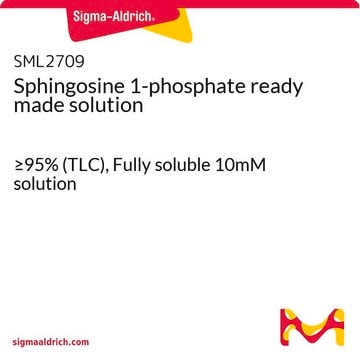SRP0191
Sphingosine-1-phosphate lyase1 Active human
recombinant, expressed in baculovirus infected insect cells, ≥70% (SDS-PAGE)
Synonim(y):
SGPL1, SP-lyase 1, hSPL
Zaloguj sięWyświetlanie cen organizacyjnych i kontraktowych
About This Item
Kod UNSPSC:
12352200
NACRES:
NA.32
Polecane produkty
pochodzenie biologiczne
human
rekombinowane
expressed in baculovirus infected insect cells
Próba
≥70% (SDS-PAGE)
Postać
aqueous solution
masa cząsteczkowa
57.5 kDa
opakowanie
pkg of 10 μg
warunki przechowywania
avoid repeated freeze/thaw cycles
stężenie
0.19 mg/mL
numer dostępu NCBI
numer dostępu UniProt
Warunki transportu
dry ice
temp. przechowywania
−70°C
informacje o genach
human ... SGPL1(8879)
Opis ogólny
SGPL1 (sphingosine-1-phosphate lyase 1) is an ER (endoplasmic reticulum) enzyme which shows a wide level of tissue expression. This protein is composed of putative 568 amino acids, and has a molecular weight of 63.5kDa. This enzyme is a member of the pyridoxal 5′-phosphate-dependent carbon-carbon lyases, which form a subclass of aldehyde lyases. It is a type III membrane protein, also known as type I membrane protein which lacks a cleavable N-terminal signal sequence. The single transmembrane segment is in proximity to the N-terminal which faces the ER lumen. The catalytic region faces the cytoplasm.
Zastosowanie
Useful for the study of biochemical function.
Działania biochem./fizjol.
SGPL1 (sphingosine-1-phosphate lyase 1) enzyme is involved in the synthesis of long-chain aliphatic aldehydes which occurs during several metabolic processes, such as peroxisomal α-oxidation of 3-methyl-branched fatty acids and 2-hydroxy long-chain fatty acids, microsomal oxidation of long-chain alcohols, prenylated protein degradation in the lysosomes, microsomal degradation of phosphorylated sphingoid bases, attack of plasmalogens by myeloperoxidase (MPO)-derived hypochlorous acid, and degradation of (lyso)plasmalogens in the microsomes.s This protein shows reduced expression in OSCC (oral squamous cell carcinoma), colon and prostate cancers, and this is associated with poor prognosis.
Postać fizyczna
Formulated in 25 mM Tris-HCl, pH 8.0, 100 mM NaCl, 0.05% Tween-20, 10% glycerol, 3 mM DTT, 0.5 mM pyridoxal 5′ phosphate monohydrate.
Uwaga dotycząca przygotowania
Thaw on ice. Upon first thaw, briefly spin tube containing enzyme to recover full content of the tube. Aliquot enzyme into single use aliquots. Store remaining undiluted enzyme in aliquots at -70°C. Note: Enzyme is very sensitive to freeze/thaw cycles.
This page may contain text that has been machine translated.
Kod klasy składowania
12 - Non Combustible Liquids
Klasa zagrożenia wodnego (WGK)
WGK 1
Temperatura zapłonu (°F)
Not applicable
Temperatura zapłonu (°C)
Not applicable
Certyfikaty analizy (CoA)
Poszukaj Certyfikaty analizy (CoA), wpisując numer partii/serii produktów. Numery serii i partii można znaleźć na etykiecie produktu po słowach „seria” lub „partia”.
Masz już ten produkt?
Dokumenty związane z niedawno zakupionymi produktami zostały zamieszczone w Bibliotece dokumentów.
Sphingosine 1-phosphate lyase deficiency disrupts lipid homeostasis in liver.
Bektas M, et al.
The Journal of Biological Chemistry, 285(14), 10880-10889 (2010)
Aberrant expression of the S1P regulating enzymes, SPHK1 and SGPL1, contributes to a migratory phenotype in OSCC mediated through S1PR2.
Patmanathan SN, et al.
Scientific Reports, 6:25650 (2016)
Serena Mezzar et al.
Journal of lipid research, 55(3), 573-582 (2013-12-11)
Long-chain aldehydes are commonly produced in various processes, such as peroxisomal α-oxidation of long-chain 3-methyl-branched and 2-hydroxy fatty acids and microsomal breakdown of phosphorylated sphingoid bases. The enzymes involved in the aldehyde-generating steps of these processes are 2-hydroxyacyl-CoA lyase (HACL1)
Sphingosine 1-phosphate lyase, a key regulator of sphingosine 1-phosphate signaling and function.
Serra M and Saba JD
Advances in Enzyme Regulation, 50(1), 349-362 (2010)
Nasz zespół naukowców ma doświadczenie we wszystkich obszarach badań, w tym w naukach przyrodniczych, materiałoznawstwie, syntezie chemicznej, chromatografii, analityce i wielu innych dziedzinach.
Skontaktuj się z zespołem ds. pomocy technicznej






